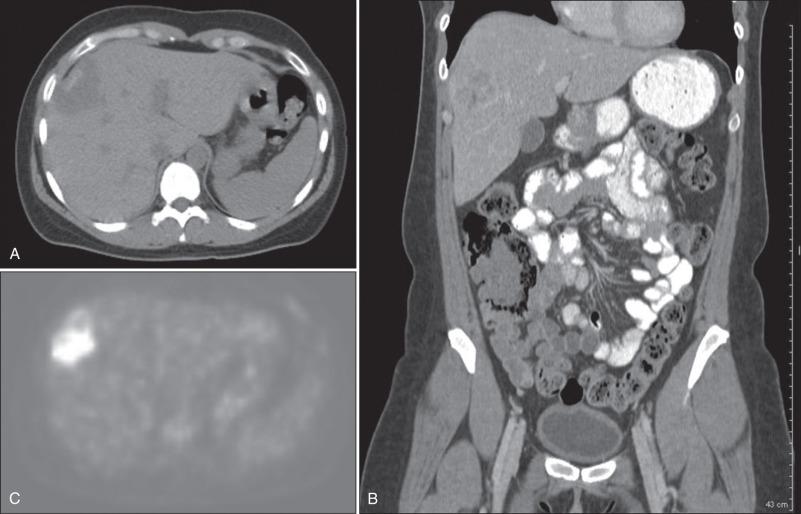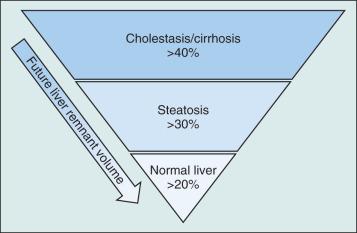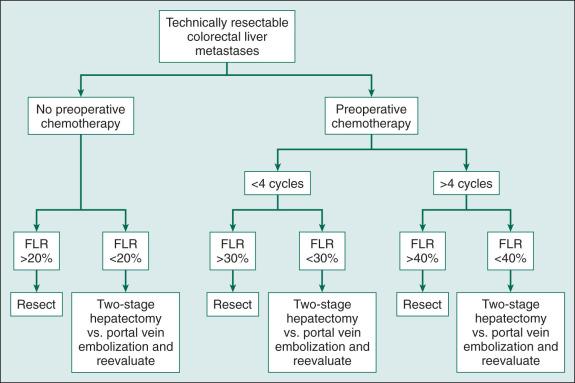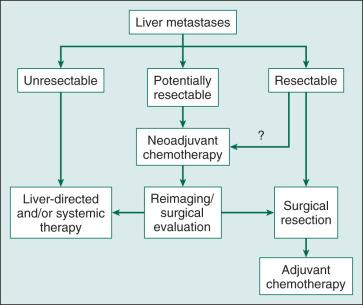Physical Address
304 North Cardinal St.
Dorchester Center, MA 02124
The liver is a common site of metastatic disease in most gastrointestinal cancers owing to hepatic portal venous drainage.
Clinical risk scores, which predict prognosis for metastatic liver disease, are less frequently used clinically in the current era of improved chemotherapy and more aggressive surgical decision making.
Contrast-enhanced computed tomography is the most widely used imaging modality to detect liver metastases, with a sensitivity of up to 93% and a specificity of up to 100%.
Percutaneous liver biopsy is rarely indicated.
Preoperative liver function and use of neoadjuvant chemotherapy influence the minimum safe size of the future liver remnant after hepatic resection.
Surgical contraindications have evolved such that decision is based on ability to achieve R0 resection, lack of unresectable extrahepatic disease, and patient preoperative comorbidities.
Improvements in surgical technique and perioperative management have allowed for safer hepatic resections.
Hepatic resection is the first-line treatment for patients with resectable liver metastases, with 5-year survival rates of 25% to 58% and 10-year survival rates of 20% to 39%.
Oxaliplatin- and irinotecan-based perioperative chemotherapy regimens are the most commonly used adjunctive treatment of liver metastases.
In approximately 20% of patients, initially unresectable liver metastases will become resectable after administration of chemotherapy.
Portal vein embolization and two-staged hepatectomy are two strategies that improve resectability by maximizing the size of the future liver remnant.
Unresectable liver metastases can be treated with a number of liver-directed therapies, including radiofrequency ablation, microwave ablation, hepatic artery infusion, and yttrium-90 radioembolization.
Surgical debulking of neuroendocrine liver metastases can relieve symptoms and improve survival, but recurrence rates are high.
Hepatic resection can be considered in patients with metastatic gastrointestinal stromal tumor (GIST) with stable or isolated progression of hepatic disease on tyrosine kinase inhibitor therapy.
Noncolorectal nonneuroendocrine liver metastases are increasingly the subject of nonrandomized trials, but outcomes are on average poorer than for colorectal liver metastases.
The liver is the most common site for gastrointestinal tumor metastasis owing to mesenteric venous outflow through the portal vein. The most common liver metastasis is colorectal cancer. Colorectal cancer is the third leading cancer-related cause of death in the United States. Approximately 15% to 20% of patients with colorectal cancer have synchronous liver metastases at presentation, and 50% will develop liver metastases at some point. Metastatic disease to the liver is also commonly seen in lung cancer, neuroendocrine tumors, gastrointestinal stromal tumors (GISTs), breast cancer, gastric cancer, melanoma, and pancreatic cancer.
The liver's unique biology has led to the development of numerous survival-enhancing, and possibly curative, treatments. When colorectal metastases are isolated to the liver and surgically resectable, 5-year overall survival (OS) rates of 25% to 58% have been reported. Surgical candidacy is limited by a patient's preoperative health status, anatomic location, and hepatic reserve. Given improved surgical techniques and postoperative care, there is a trend toward more aggressive surgical management of liver metastases. Despite this, only about 20% of patients can be offered a potentially curative resection at time of initial presentation. This has led to further study of systemic chemotherapy and local liver-directed therapy options. This chapter reviews the treatment of liver metastases, focusing on metastatic colorectal cancer, and the interplay among surgery, systemic therapy, and liver-directed therapies.
Evaluation of patients with liver metastases is initially focused on assessing their candidacy for surgical resection. Per current National Comprehensive Cancer Network (NCCN) guidelines, patients should be categorized at first presentation as having surgically resectable disease, potentially convertible disease, or unresectable disease. Resectability has been a moving target, with the evolution of surgical techniques allowing for more aggressive operative decision making. Unresectable extrahepatic metastatic disease is a contraindication to hepatic resection. The number of metastases and location of metastatic disease are critical in surgical decision making but do not represent an absolute contraindication. More subtle factors such as tumor proximity to major vascular and biliary structures, predicted margin status, hepatic functional reserve, and impact of prior chemotherapy also must be considered.
The two most studied clinical risk scores (CRSs) for prognostication in patients with metastatic colorectal cancer to the liver were reported by Nordlinger and Fong. They were developed to attempt to predict which patients would benefit from a metastasectomy based on available preoperative variables. In addition to the five preoperative variables, Fong found positive margins and extrahepatic disease to be independent predictors of poor outcomes. The total risk score was shown to be highly predictive of survival ( Table 58.1 ). The OS rates stratified by preoperative risk score are shown in Fig. 58.1 .
| Score | O verall S urvival R ate ( % ) | Median (Mo) | |||||
|---|---|---|---|---|---|---|---|
| One-Year OS | Two-Year OS | Three-Year OS | Four-Year OS | Five-Year OS | |||
| Risk factors a for tumor recurrence are node-positive primary, disease-free interval <12 mo, more than one tumor, preoperative carcinoembryonic antigen >200 ng/mL, and tumor size >5 cm | 0 | 93 | 79 | 72 | 60 | 60 | 74 |
| 1 | 91 | 76 | 66 | 54 | 44 | 51 | |
| 2 | 89 | 73 | 60 | 51 | 40 | 47 | |
| 3 | 86 | 69 | 42 | 25 | 20 | 33 | |
| 4 | 70 | 45 | 38 | 29 | 25 | 20 | |
| 5 | 71 | 45 | 27 | 14 | 14 | 22 | |
a Each risk factor is given 1 point to generate a Clinical Risk Score for tumor recurrence.
![Figure 58.1, Survival rate after hepatic resection as related to clinical risk score. ( Blue circles : score = 0 [ n = 52]; red triangles : score = 1 [ n = 262]; green circles : score = 2 [ n = 350]; blue squares : score = 3 [ n = 243]; orange squares : score = 4 [ n = 80]; blue triangles : score = 5 [ n = 14]; P < .00001.) Figure 58.1, Survival rate after hepatic resection as related to clinical risk score. ( Blue circles : score = 0 [ n = 52]; red triangles : score = 1 [ n = 262]; green circles : score = 2 [ n = 350]; blue squares : score = 3 [ n = 243]; orange squares : score = 4 [ n = 80]; blue triangles : score = 5 [ n = 14]; P < .00001.)](https://storage.googleapis.com/dl.dentistrykey.com/clinical/LiverMetastases/0_3s20B978032347674400058X.jpg)
These risk scores were developed before current chemotherapy regimens were developed and neoadjuvant therapy was commonplace. It is not clear if the CRSs remain valid after neoadjuvant therapy. Regardless, decisions about whether or not to surgically resect a metastatic liver tumor are nuanced, and although CRSs can be helpful in the initial patient discussion, treatment decisions are best made on an individualized basis within multidisciplinary teams.
Computed tomography (CT) is the most commonly used imaging modality both to evaluate patients for the presence of liver metastatic disease and to inform surgical planning. Contrast-enhanced dual-phase (hepatic arterial and portal venous) CT has high sensitivity (72% to 93%) and specificity (91% to 100%) for detecting liver metastases. In most patients with colorectal cancer, portal venous phase imaging is sufficient; however, for patients with more vascular primary tumors such as renal cell carcinoma, melanoma, or neuroendocrine tumors, the addition of the arterial phase improves detection. Three-dimensional liver reconstruction does not add diagnostic value but can enable accurate prediction of future liver remnant (FLR) and aids in surgical decision making and operative planning.
Liver magnetic resonance imaging (MRI) provides detailed information on the anatomic and morphologic features of tumors, especially in the setting of chronic liver disease. MRI is also the preferred imaging study for detection of hepatic metastases in patients with iodine allergy or renal insufficiency. The respective sensitivity and specificity of MRI for colorectal liver metastases were 82% and 93% in one prospective study. These were similar to CT, which argues for a more selective use of MRI in staging, specifically when there are equivocal results on CT or if further anatomic detail is needed for surgical planning. A pooled meta-analysis comparing imaging modalities after neoadjuvant chemotherapy found that MRI had superior sensitivity (86%) when compared with CT (70%), fluorodeoxyglucose–positron emission tomography (FDG-PET; 55%), and PET-CT (51%).
PET combined with CT should be used selectively in evaluation of patients with liver metastases ( Fig. 58.2 ). PET-CT previously was recommended before surgical resection of liver metastases to evaluate for occult metastatic disease, with one study reporting a 31% upstaging rate. However, a randomized trial of 400 patients with surgically resectable disease based on CT compared additional PET-CT versus no additional imaging. Only 8% of the patients in the PET-CT group had a change in surgical management (2.7% did not undergo operation; the remainder underwent a more extensive surgical procedure). Another 8% had a false-positive result requiring further workup. Survival was similar between the two groups. Conversely, a smaller randomized trial of 150 patients showed that the addition of PET-CT reduced the rate of futile laparotomies from 45% to 28%. NCCN guidelines now discourage routine use of PET-CT in the staging of resectable metastatic colorectal cancer. However, it may still be helpful in certain clinical situations. Of note, because chemotherapy decreases tumor cell metabolic rate, PET-CT findings may be transiently negative after chemotherapy administration.

Patients undergoing a hepatic resection for metastatic disease should undergo intraoperative liver ultrasonography at the onset of the operation to confirm R0 resectability. Intraoperative ultrasound examination identifies occult liver metastases indicative of incurable disease in 25% to 48% of patients. Intraoperative ultrasonography in conjunction with bimanual palpation of the liver parenchyma had a reported 82% sensitivity for detection of liver metastases. As laparoscopic techniques for hepatectomies have emerged, the use of laparoscopic ultrasonography has become essential. Studies investigating the benefit of contrast-enhanced intraoperative ultrasonography have mixed results, and thus its use is not standard at this time.
The use of percutaneous biopsy for definitive tissue diagnosis of liver metastases has raised concern about the potential for tumor seeding along a percutaneous biopsy tract, particularly in patients who would otherwise be good surgical candidates. Much of the literature on this topic is focused on tract seeding after percutaneous biopsy of primary liver tumors, and very few cases of tract seeding after fine-needle aspiration have been reported. Tract seeding has been described as rare, but in several small series, rates of 9% to 19% have been reported after percutaneous biopsy of liver metastases. Given the accuracy of liver imaging in the diagnosis of liver metastases, percutaneous biopsy is rarely indicated but can be considered if confirmation of tumor genotype is relevant for subsequent treatment decisions.
A critical component of the preoperative workup for hepatic resection is calculating the predicted postoperative FLR. FLR is expressed as the percentage of liver volume remaining after the planned resection and is a surrogate for estimation of postsurgical liver function. FLR is measured most frequently with CT three-dimensional reconstruction and then normalized to a patient's body surface area to calculate the total liver volume (TLV).
Patients with an otherwise normal liver are able to tolerate an FLR of 20% safely. This recommendation was derived from two large series. The first showed that patients with an FLR of less than 20% had a 50% postoperative complication rate compared with to 13% in those with an FLR greater than 20%. A subsequent series of over 300 patients showed that patients with an FLR of less than 20% had a 34% rate of liver insufficiency and 11% mortality from liver failure compared with 10% and 3%, respectively, in patients with an FLR of 20% to 30%.
However, the majority of contemporary patients have some degree of preexisting hepatotoxicity. Patients with hepatotoxicity require an FLR of at least 30%, and those with underlying hepatic disease are recommended to have an FLR of over 40% ( Fig. 58.3 ). Fig. 58.4 depicts an algorithm for approaching resectable liver metastases in the setting of normal hepatic function.


In the setting of chemotherapy-induced steatosis, an even larger FLR may be needed. In a study of 101 patients with colorectal liver metastases who underwent preoperative chemotherapy, investigators found that the safe FLR thresholds in terms of overall morbidity, sepsis, and liver failure were 44.8%, 43.1%, and 37.7%, respectively. Chemotherapy-induced steatosis has been shown to impede liver regeneration, but the degree of its influence on postoperative morbidity and mortality has been debated. In a review of 406 patients with colorectal liver metastases, irinotecan was associated with more steatohepatitis compared with no chemotherapy (18.9% versus 1.9%; P < .001). Patients with steatohepatitis had an increased 90-day mortality rate (14.7% versus 1.6%; P = .001). Patients with steatosis have further been shown in a systematic review to have twice the number of postoperative complications, and when severe steatosis was present (>30%), there was a threefold increase in postoperative mortality. Although there have been no prospective trials, expert consensus states that the minimum FLR after neoadjuvant chemotherapy should be 30%.
Routine hepatic biochemical tests including bilirubin, aspartate and alanine aminotransferase, and alkaline phosphatase levels are an essential component of preoperative hepatic function assessment. A coagulation panel and platelet count also provide information on hepatic function. If there is a concern, hyaluronic acid concentration can provide insight into the degree of hepatic fibrosis and sinusoidal endothelial damage. The presence of underlying hepatic dysfunction can suggest that the role of surgical resection may be more limited. These patients are not candidates for resection, require a more limited resection, or should be allowed to recover longer from any insult to their liver before resection.
Diagnostic laparoscopy is used in many abdominal malignancies to detect occult intraperitoneal metastatic disease before a major surgical resection. Its role in patients with metastatic colorectal disease confined to the liver is evolving, and it is being used more selectively. Some advocate the use of the CRS for this decision. When more than two factors were present, there was a 42% chance of discovery of occult metastatic disease. In addition, in a series of 200 patients, there was a higher yield with staging laparoscopy the higher the CRS; diagnostic laparoscopy enabled detection of 58% of the patients who ultimately had surgically incurable disease, changing the management of 19.5% of the patients. However, with improved imaging technology and because this risk calculator was developed in the era before the FOLFOX and FOLFIRI regimens, most hepatobiliary surgeons do not weigh the CRS heavily in their decision making for diagnostic laparoscopy. Rather, it is useful when low-volume peritoneal disease is suggested on preoperative images or in selected high-risk cases. The Society of American Gastrointestinal and Endoscopic Surgeons (SAGES) recommends that if diagnostic laparoscopy is to be performed, one should immediately proceed to hepatic resection if no other occult disease is found, in order to minimize treatment delay and cost.
Liver metastases develop in half of patients with colorectal cancer. Unfortunately, approximately 80% of these patients have unresectable disease at the time of presentation. If no further treatment is offered, the median survival for patients with unresectable liver metastases from colorectal cancer is generally poor, with roughly a 30% 1-year survival rate and a 0% to 5% 5-year survival rate ( Table 58.2 ). Several studies have demonstrated that patients with resectable liver metastases who do not undergo surgery fare slightly better, with 1-year survival rates ranging between 20% and 80% and median survival rates ranging from 10.6 to 21 months. A retrospective analysis of 484 patients with untreated colorectal liver metastases identified six independent determinants of survival at multivariable analysis. The strongest predictive factor was percentage of metastatic liver tumor burden. The remaining significant factors were primary tumor grade, extrahepatic disease, mesenteric lymph node involvement, serum carcinoembryonic antigen (CEA) level, and age. Survival is significantly improved in patients with resectable liver metastases who do undergo surgery and should be discussed with all patients; this will be further detailed in subsequent sections.
| Study | No. of Patients | O verall S urvival R ate | Median Survival (Mo) | ||
|---|---|---|---|---|---|
| One-Year OS (%) | Three-Year OS (%) | Five-Year OS (%) | |||
| Wood, 1976 | |||||
| Solitary | 15 | 60 | 13.3 | 8 | 16.7 a |
| Multiple unilobar | 11 | 27 | 9.9 | 10.6 a | |
| Wanebo, 1978 | 18 | 72 | 17 | 19 | |
| Wagner, 1984 | |||||
| Solitary | 39 | 20 | 21 | ||
| Multiple unilobar | 31 | 15 | |||
| Scheele, 1990 | 10 | 14.2 | |||
| Norstein, 1997 | 10 | 80 | 0 | 0 | 18 |
Survival for patients with metastatic colorectal cancer has significantly improved in the past decade with the advent of improved local and systemic treatment options and the increased use of resection. As surgical management of liver metastases has become more aggressive, long-term survival and even cure are now possible. Over the past two decades, in series of patients who have undergone resection of colorectal liver metastases, 5-year survival rates of 25% to 58% and 10-year survival rates of 20% to 39% have been reported ( Table 58.3 ).
| Study | No. of Patients | Operative Mortality (%) | O verall S urvival R ate | Median Survival (Mo) | |||
|---|---|---|---|---|---|---|---|
| One-Year OS (%) | Three-Year OS (%) | Five-Year OS (%) | Ten-Year OS (%) | ||||
| Adson, 1984 | 141 | 3 | 82 | 40 | 25 | 24 | |
| Hughes, 1986 | 607 | 33 | |||||
| Scheele, 1991 | 219 | 5.5 | 39 | 28 | |||
| Scheele, 1995 | 434 | 4 | 85 | 45 | 33 | 20 | 40 |
| Nordlinger, 1996 | 1568 | 28 | |||||
| Jamison, 1997 | 280 | 4 | 84 | 27 | 20 | 33 | |
| Fong, 1999 | 1001 | 2.8 | 89 | 57 | 37 | 22 | 42 |
| Iwatuski, 1999 | 305 | 1 | 88 | 48 | 32 | 24 | 34 |
| Choti, 2002 | 226 | 1 | 93 | 57 | 40 | 26 | 46 |
| Abdulla, 2004 | 190 | 73 | 58 | 21 | |||
| Wei, 2006 | 423 | 1.6 | 93 | 47 | 28 | ||
| Morris, 2010 | 3116 | 44 | |||||
| Swan, 2011 | 1202 | 1.2 | 42.3 | 48 | |||
| Vigano, 2012 | 192 | 1 | 46 | ||||
| Beppu, 2012 | 727 | 0.55 | 64 | 48 | 39 | ||
The general approach to patients with liver metastases begins with determination of surgical resectability and is shown in Fig. 58.5 . The initial workup of a patient with metastatic colorectal cancer confined to the liver should involve a hepatobiliary surgical consultation. Historically, hepatic resection was not considered if patients had more than four lesions in the same lobe, bilobar disease, inability to achieve 1-cm margins, or portal lymph node metastases. However, with advances in surgical technique and adjuvant therapy, there is a role for more aggressive surgical decision making. The current paradigm focuses simply on whether there is an adequate FLR if all disease can be removed with a negative margin. Specifically, at least two adjacent liver segments with adequate vascular and biliary flow must be preserved. The functional liver remnant must be at least 20% to 40% based on patient characteristics (see earlier section Evaluation of the Future Liver Remnant ). Most liver surgeons also require that there be no involvement of the hepatic artery, portal vein, major bile ducts, or paraaortic lymph nodes.

If clinically indicated, fine-needle aspiration can be performed for pathologic confirmation. There is a small but documented risk of needle tract seeding. If liver metastases are discovered at the time of colectomy, needle biopsy should be performed (rather than biopsy forceps) to minimize the risk of peritoneal seeding.
Patients who are good surgical candidates with resectable liver disease benefit from hepatic resection. The reported 5-year OS rates in surgical series have been 25% to 58%. Comparatively, systemic chemotherapy regimens alone have 5-year OS rates of 10% to 11%. Thus early referral to a hepatobiliary surgeon is prudent.
As stated above, the patient selection criteria for metastatic disease to the liver has been liberalized to include those who can have all disease resected with a negative margin and an adequate future liver remnant. An international consensus statement defines the absolute criteria for unresectability to be untreatable extra-hepatic disease, patient unfitness for surgery, or involvement of greater than 70% of the liver or 6 segments. Furthermore, involvement of the proper hepatic artery, main portal vein, celiac/paraaortic axis, or major bile duct can affect technical resectability and underscore the imperativeness of patient evaluation by hepatic surgeon prior to treatment initiation. In select circumstances, hepatic vein or vein cava resection and reconstruction can be offered. Additionally, select patients with isolated extra-hepatic disease, typically lung metastases, are now being considered for resection as there has been shown to be a survival benefit in this population following lung metastatectomy.
Become a Clinical Tree membership for Full access and enjoy Unlimited articles
If you are a member. Log in here